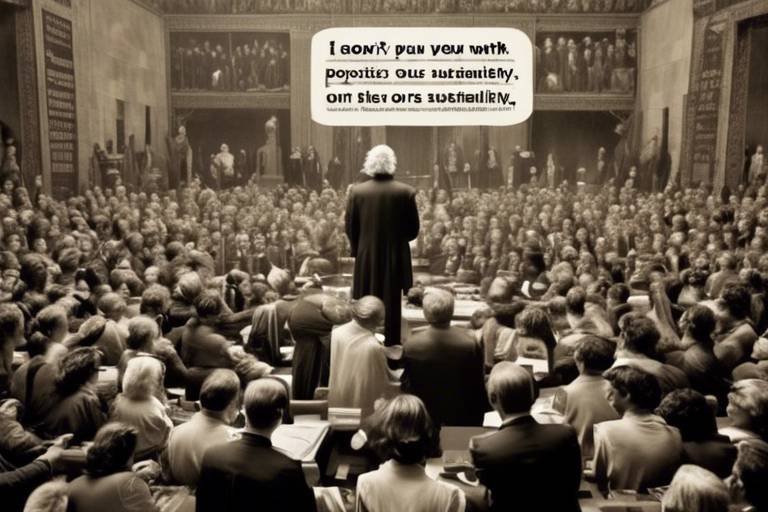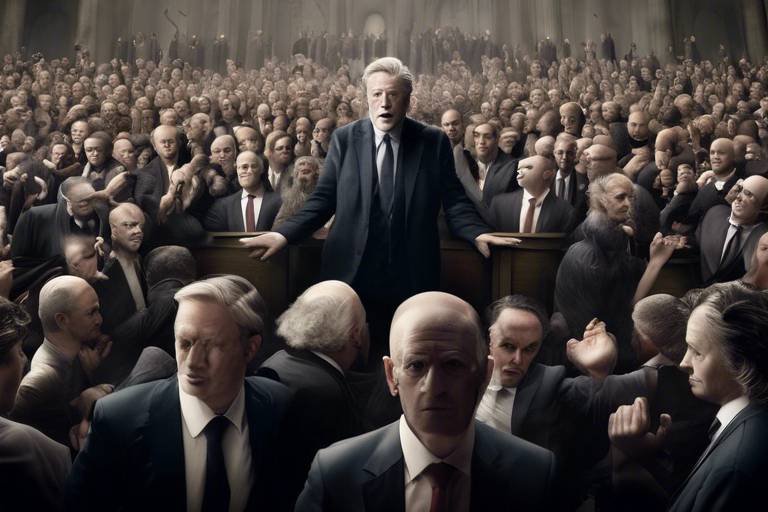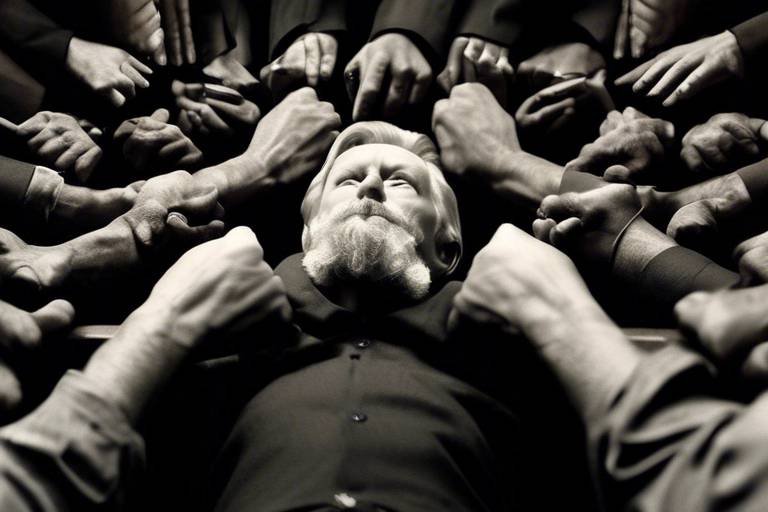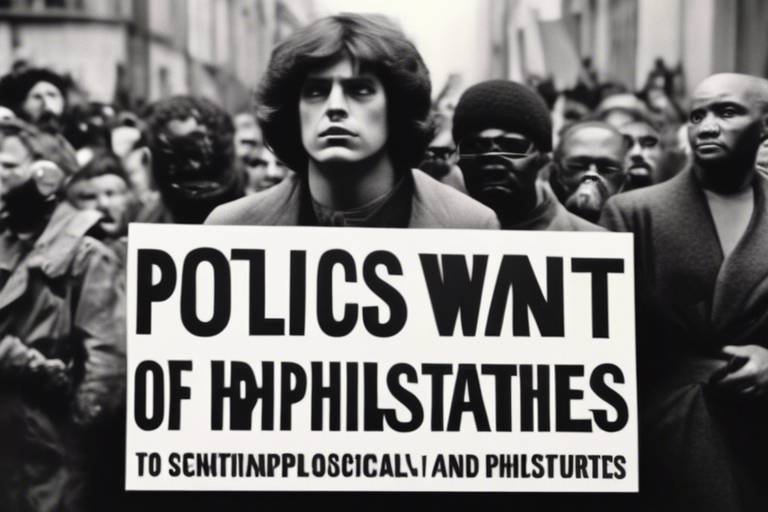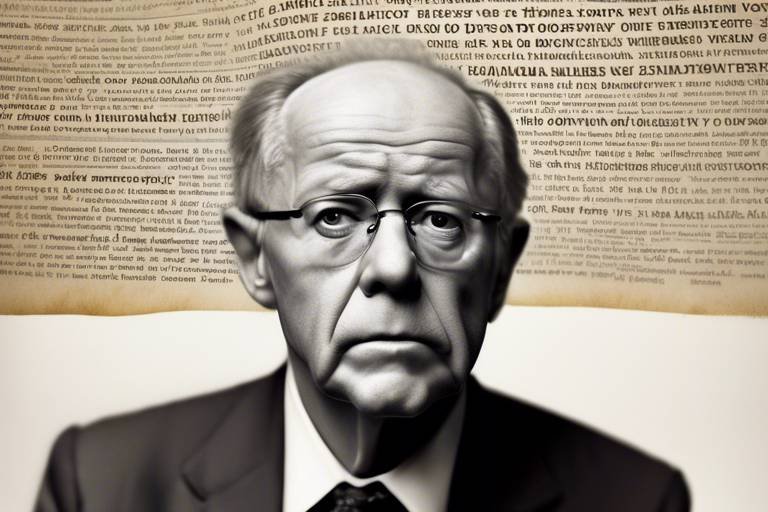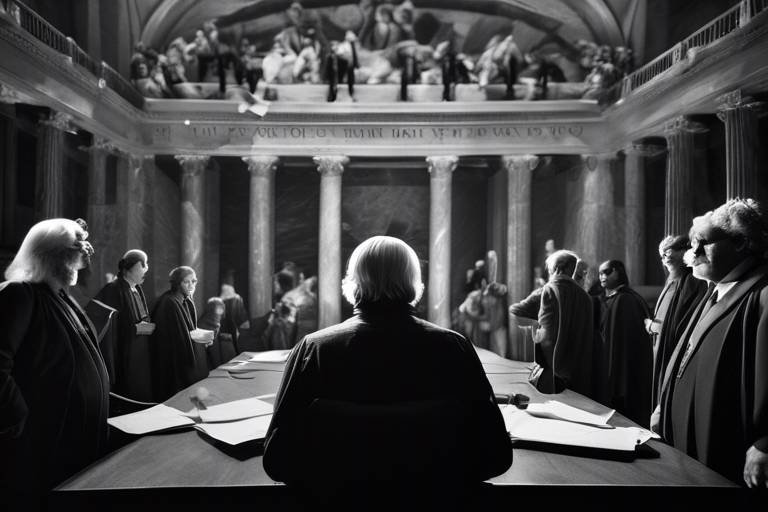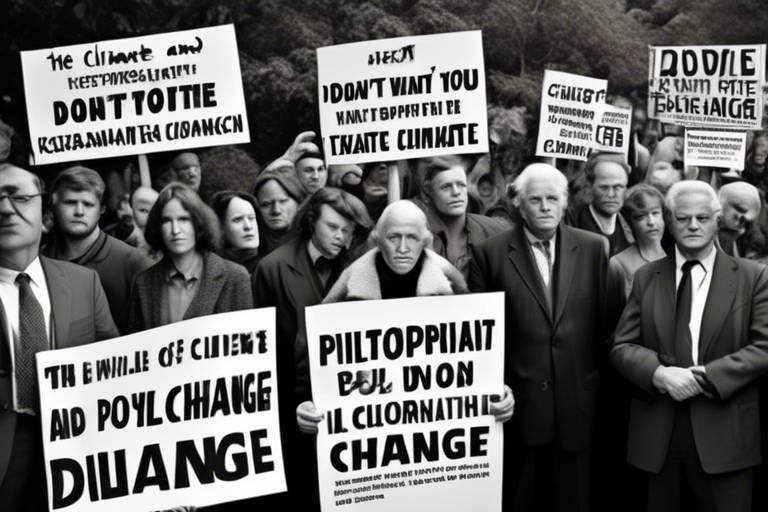Philosophy and the Origins of Communism
The emergence of communism as a political and economic ideology is deeply rooted in a rich tapestry of philosophical thought. This article aims to unravel the intricate connections between key philosophical ideas and the development of communist theory. At its core, communism seeks to address the inequalities and injustices that arise from capitalist systems, proposing a radical restructuring of society based on collective ownership and egalitarian principles. But how did we get here? What philosophical foundations paved the way for such revolutionary ideas?
To understand the origins of communism, we must first look at the thinkers who shaped its theoretical underpinnings. Karl Marx and Friedrich Engels stand out as the primary architects of communist thought, but they did not emerge in a vacuum. Their ideas were influenced by a variety of philosophical traditions, including German idealism, particularly the works of Georg Wilhelm Friedrich Hegel, and the socio-economic realities of their time. By examining these influences, we can better appreciate how communism evolved as a response to the challenges posed by industrialization and capitalism.
Moreover, the historical context in which these ideas flourished cannot be ignored. The rise of industrial capitalism in the 19th century created stark class divisions, leading to widespread social unrest. As workers labored under harsh conditions, the seeds of discontent began to sprout, setting the stage for revolutionary thought. Thus, communism emerged not merely as an abstract ideology but as a practical response to the pressing issues of its time.
In essence, the philosophy of communism is a critique of the existing socio-economic order, advocating for a system where the means of production are collectively owned. This radical proposal challenges the very foundations of capitalism and raises fundamental questions about the nature of freedom, equality, and justice. As we delve deeper into the philosophical roots of communism, we will explore how key thinkers articulated their visions of a classless society and the implications of their ideas for future generations.
- What is communism? Communism is a political and economic ideology that advocates for a classless society in which the means of production are owned collectively.
- Who were the key figures in the development of communist thought? The most significant figures include Karl Marx and Friedrich Engels, who laid the theoretical groundwork for communism.
- How did historical events influence the rise of communism? The rise of industrial capitalism and the resulting class struggles played a crucial role in shaping communist ideology, as they highlighted the inequalities within capitalist systems.
- What are the main principles of Marxism? Key principles include historical materialism, the labor theory of value, and the idea that class struggle is the driving force of societal change.

Key Philosophers Influencing Communism
This article explores the philosophical foundations that led to the emergence of communism, examining key thinkers, ideologies, and historical contexts that shaped its development.
When we think about the roots of communism, two names immediately pop up: Karl Marx and Friedrich Engels. These thinkers didn't just contribute to a new political ideology; they revolutionized the way we perceive society and its structures. Imagine a world where the struggles of the working class are not just seen as individual hardships but as part of a larger, systemic issue. That’s the essence of their work.
Marx and Engels were deeply influenced by the social conditions of their time, particularly the rise of industrial capitalism. They observed how the factory system created a stark divide between the bourgeoisie (the capitalists) and the proletariat (the working class). This observation led them to formulate ideas that would eventually become the backbone of communist thought. Their seminal work, The Communist Manifesto, is a clarion call for the oppressed, urging them to recognize their collective power. But their ideas didn’t emerge in a vacuum; they were influenced by several key philosophical traditions.
One of the most significant influences on Marxist theory was the philosophy of Georg Wilhelm Friedrich Hegel. Hegel's dialectical method, which emphasizes the importance of contradictions and their resolution, provided Marx with a framework to analyze societal changes. However, Marx turned Hegel's ideas on their head by applying them to material conditions rather than abstract ideas. This shift was crucial in developing what we now call historical materialism, a concept that argues that material conditions and economic factors primarily drive societal change.
In addition to Hegel, Marx was also influenced by the German Ideology, which emphasized the role of human labor in shaping society. Marx believed that labor was not just a means of survival; it was a fundamental aspect of human identity. This idea is encapsulated in his Labor Theory of Value, which posits that the value of a commodity is determined by the amount of socially necessary labor time required for its production. This theory laid the groundwork for critiquing capitalism and understanding how exploitation occurs within capitalist systems.
Engels, Marx's collaborator, also played a crucial role in shaping communist thought. His work, The Origin of the Family, Private Property and the State, argues that the family structure, private property, and the state are products of historical development and serve the interests of the ruling class. Engels brought a unique perspective to the discussion, emphasizing the importance of gender and family relations in understanding social dynamics.
To sum up, the philosophical foundations of communism are deeply rooted in the works of Marx and Engels, who synthesized various philosophical traditions to create a compelling narrative about class struggle and societal change. Their ideas continue to resonate today, as we grapple with issues of inequality and exploitation in our modern world.
- Who were the main philosophers behind communism? The primary philosophers influencing communism were Karl Marx and Friedrich Engels, whose ideas laid the groundwork for communist theory.
- What is historical materialism? Historical materialism is a Marxist concept that interprets societal development through economic factors and class struggles.
- How did Hegel influence Marx? Hegel's dialectical method influenced Marx's understanding of societal change, but Marx applied it to material conditions rather than abstract ideas.
- What is the Labor Theory of Value? The Labor Theory of Value posits that the value of a commodity is determined by the labor required for its production.

The Role of Historical Materialism
Historical materialism is a cornerstone of Marxist philosophy, serving as a lens through which we can understand the evolution of societies and their economic structures. At its core, historical materialism posits that the material conditions of a society—particularly its economic base—are the primary drivers of social change, shaping everything from culture to politics. This perspective shifts the focus from abstract ideas and ideologies to tangible economic realities, highlighting how class struggles and economic factors influence human development.
To grasp the significance of historical materialism, one must recognize its departure from idealist philosophies that prioritize ideas over material conditions. Marx and Engels argued that it is not consciousness that determines life, but rather, life that determines consciousness. This means that the way people produce goods and services fundamentally shapes their social relations and, ultimately, their ideas. For instance, in a capitalist society, the relationship between the bourgeoisie (the ruling class) and the proletariat (the working class) is defined by exploitation and economic power, leading to a distinct class consciousness that reflects this dynamic.
Historical materialism can be broken down into several key components that illustrate its role in analyzing societal development:
- Economic Base and Superstructure: The economic base of a society consists of its productive forces and relations of production. This base shapes the superstructure, which includes culture, politics, and ideology. Changes in the economic base lead to shifts in the superstructure, demonstrating the interconnectedness of material conditions and social structures.
- Class Struggle: Central to historical materialism is the idea that history is driven by class struggles. These struggles arise from the inherent conflicts of interest between different classes, particularly in capitalist societies where the bourgeoisie and proletariat have opposing goals. Marx believed that these conflicts would ultimately lead to revolutionary change and the establishment of a classless society.
- Dialectical Method: Inspired by Hegel, Marx employed a dialectical approach to understanding societal progress. This method emphasizes that contradictions within a society—such as those between different classes—create tensions that propel historical change. For example, the contradictions of capitalism, such as wealth inequality and worker alienation, can lead to revolutionary movements aimed at restructuring society.
To illustrate the impact of historical materialism, consider the transition from feudalism to capitalism. This shift was not merely a result of changing ideas but was deeply rooted in material conditions, such as technological advancements and changes in productive forces. As the economy evolved, so did the class structure, leading to the rise of the bourgeoisie and the decline of feudal lords. This transformation was accompanied by significant social upheaval, as the new capitalist class sought to establish its dominance, often at the expense of the working class.
In summary, historical materialism provides a robust framework for understanding the complexities of societal development. By focusing on material conditions and class struggles, it allows us to analyze the underlying forces that shape human history. This perspective not only sheds light on the past but also offers insights into contemporary social issues, reminding us that economic factors continue to play a crucial role in shaping our world today.
What is historical materialism?
Historical materialism is a Marxist framework that posits that material conditions, particularly economic factors, drive social change and shape human consciousness.
How does historical materialism differ from idealism?
Unlike idealism, which prioritizes ideas and consciousness, historical materialism emphasizes the role of material conditions in shaping society and its ideologies.
Why is class struggle important in historical materialism?
Class struggle is central to historical materialism as it reflects the conflicts of interest between different social classes, driving historical change and the development of societies.
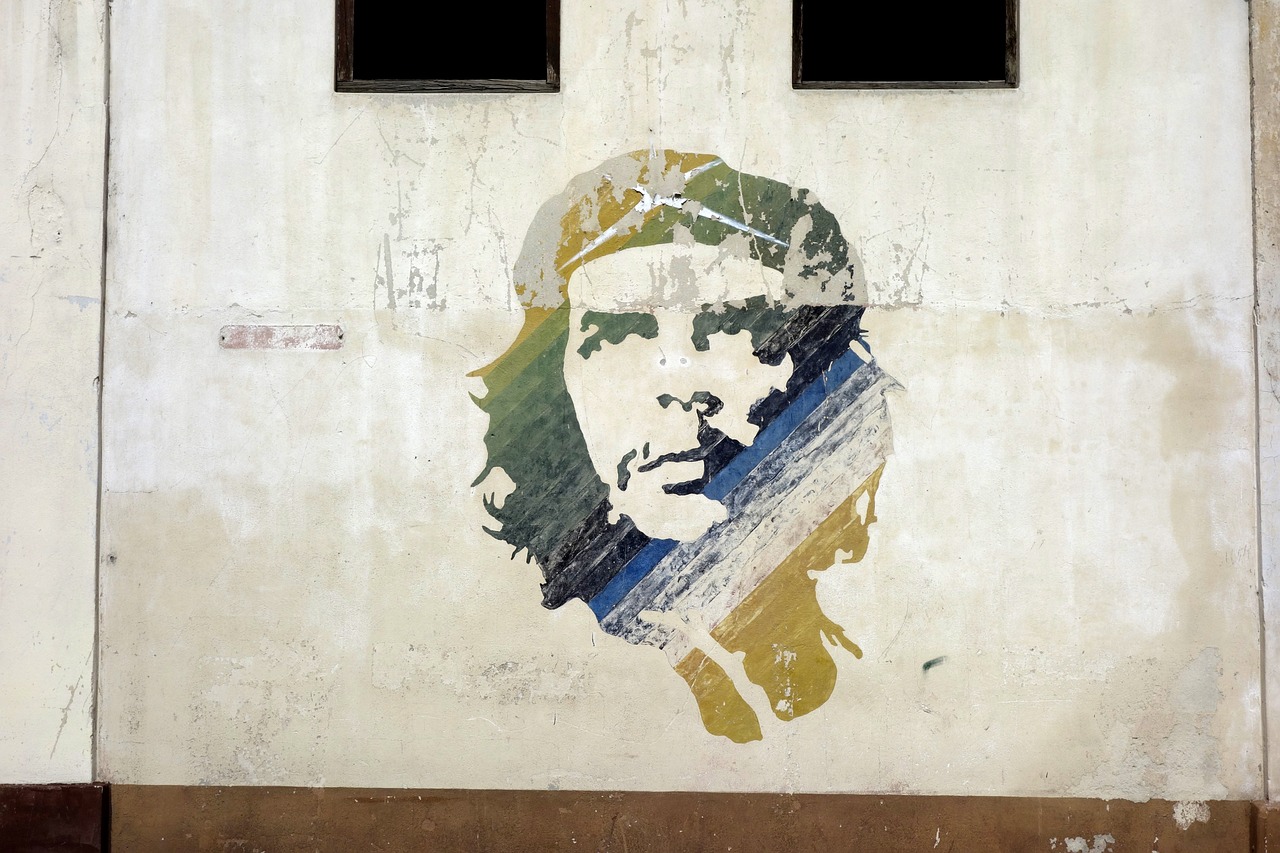
Marx's Critique of Capitalism
Karl Marx, one of the most influential thinkers in modern history, presented a profound critique of capitalism that resonates even today. His analysis wasn't just a casual observation; it was a deep dive into the very fabric of capitalist society. Marx argued that capitalism, while it spurred innovation and growth, also harbored inherent contradictions and injustices that ultimately led to its own demise. Imagine a machine that, while powerful, is constantly breaking down due to its flawed design. This metaphor captures the essence of Marx's critique.
At the heart of Marx's argument is the concept of exploitation. He posited that capitalism thrives on the exploitation of the working class, or the proletariat, by the owning class, known as the bourgeoisie. The bourgeoisie profits from the labor of the proletariat, who receive only a fraction of the value they create. This relationship creates a fundamental imbalance. In Marx's words, “The worker becomes poorer the more wealth he produces.” This cycle not only enriches a few but also impoverishes many, leading to social unrest.
Another critical aspect of Marx's critique is alienation. Under capitalism, workers become alienated from their labor, the products they create, and even from each other. Picture a factory worker who spends hours assembling products they will never use or see enjoyed by others. This disconnection leads to a sense of purposelessness and dissatisfaction, which can be detrimental to mental health and societal cohesion. Marx believed that true fulfillment comes from engaging in meaningful work, a condition that capitalism often undermines.
Moreover, Marx identified the inherent contradictions within capitalism. He argued that the system is driven by profit maximization, which leads to overproduction and underconsumption. As businesses strive to cut costs and increase profits, they often lay off workers or reduce wages, which in turn decreases the purchasing power of the very consumers they rely on. This contradiction is like a vicious cycle, where the engine of capitalism, meant to generate wealth, ultimately sows the seeds of its own crisis.
| Key Concepts in Marx's Critique | Description |
|---|---|
| Exploitation | The process by which the bourgeoisie profits from the labor of the proletariat. |
| Alienation | The disconnection workers feel from their labor and the products they create. |
| Contradictions | The conflict between profit motives and the needs of consumers, leading to economic crises. |
In summary, Marx's critique of capitalism is a multi-faceted analysis that highlights the ways in which the system exploits workers, alienates individuals, and harbors contradictions that threaten its sustainability. His insights compel us to reflect on the societal structures we inhabit and challenge us to envision a more equitable system. As we navigate the complexities of modern capitalism, Marx's thoughts remain a powerful lens through which we can examine the world around us.
- What is Marx's main argument against capitalism? Marx argues that capitalism exploits the working class and leads to social inequality and alienation.
- How does Marx define exploitation? Exploitation occurs when the bourgeoisie profits from the labor of the proletariat, paying them less than the value they produce.
- What is alienation in Marxist terms? Alienation refers to the disconnection workers feel from their labor, the products they create, and from each other.
- What are the contradictions of capitalism according to Marx? Marx believed that capitalism's drive for profit leads to overproduction and underconsumption, creating economic crises.

The Labor Theory of Value
The Labor Theory of Value is one of the cornerstone concepts in Marxist economics, and it provides a profound insight into how value is created within a capitalist system. At its core, this theory posits that the value of a commodity is directly related to the amount of socially necessary labor time required for its production. In simpler terms, the more labor that goes into making something, the more valuable it is deemed to be. This notion challenges the traditional view that value is determined solely by supply and demand, placing labor at the heart of economic value creation.
To understand this theory better, consider the following analogy: imagine you're baking a cake. The ingredients you use—flour, sugar, eggs, and frosting—each have a cost associated with them. However, the real value of the cake comes not just from these ingredients but from the time and effort you put into mixing, baking, and decorating it. Similarly, in the marketplace, the labor that goes into creating a product is what gives it its true value. Without labor, the ingredients (or raw materials) are just that—raw materials.
Marx argued that under capitalism, workers are often alienated from the products of their labor. They produce goods that they do not own, and the value they create is appropriated by capitalists, who profit from this labor without adequately compensating the workers. This leads to a fundamental contradiction in capitalism: while labor creates value, the system itself tends to undervalue the labor force. This is where the labor theory of value becomes crucial in understanding the dynamics of exploitation and class struggle.
In practical terms, the labor theory of value can be represented in a simplified table that outlines how different factors contribute to the value of goods:
| Factor | Description |
|---|---|
| Labor Time | The amount of time workers spend on producing a good. |
| Skill Level | The expertise and efficiency of the labor force involved in production. |
| Raw Materials | The cost and availability of materials necessary for production. |
| Production Conditions | The environment and tools used during the production process. |
This table illustrates how various elements interact to determine the value of a commodity, reinforcing the idea that labor is the primary source of value. Marx believed that this understanding of labor and value was essential for workers to recognize their exploitation and to unite in the struggle for fair compensation and rights.
Ultimately, the Labor Theory of Value is not just an economic principle; it serves as a rallying cry for social justice and equity in the workplace. By emphasizing the importance of labor in the creation of value, Marx laid the groundwork for a critique of capitalism that continues to resonate today. It invites us to question the structures that dictate our economic lives and challenges us to envision a system where labor is valued appropriately, and the fruits of that labor are shared more equitably among all members of society.
- What is the Labor Theory of Value? The Labor Theory of Value suggests that the value of a commodity is determined by the amount of labor required to produce it.
- How does this theory relate to capitalism? It critiques capitalism by highlighting how labor is often undervalued and exploited within capitalist systems.
- Why is the Labor Theory of Value important? It helps to understand the dynamics of economic exploitation and the relationship between labor, value, and capital.

Class Struggle and Revolution
The concept of class struggle is central to Marxist theory, serving as a lens through which we can understand the dynamics of societal change. At its core, class struggle refers to the ongoing conflict between different classes within society, primarily the bourgeoisie (the capitalist class) and the proletariat (the working class). Marx argued that this struggle is not merely a historical footnote but the driving force behind significant social transformations. Think about it: just as a river carves its path through rock, the clash of classes shapes the very fabric of society.
Marx believed that as the bourgeoisie amassed wealth and power, they inherently exploited the proletariat, leading to a growing sense of alienation among workers. This exploitation creates a fertile ground for revolution, as the oppressed class becomes increasingly aware of their plight. The idea is that the more the proletariat recognizes their exploitation, the more likely they are to rise against their oppressors. Essentially, class struggle acts as a catalyst for revolutionary change, pushing society toward the establishment of a classless society.
To better illustrate this concept, consider the following key points:
- Awareness and Consciousness: The proletariat must develop a class consciousness, understanding their collective interests and the need for solidarity.
- Political Action: Once aware, the working class is encouraged to engage in political action, forming unions and participating in strikes to demand better conditions.
- Revolution: Ultimately, this awareness and action can lead to a revolutionary movement aimed at overthrowing the capitalist system.
Marx's vision was not merely theoretical; he believed that the culmination of class struggle would result in a revolution, overthrowing the bourgeoisie and dismantling the capitalist system. This revolution would not be a spontaneous event but rather the inevitable outcome of the escalating tensions between classes. In Marx's view, the revolution would pave the way for a new society, one where resources and means of production are communally owned, ensuring that no class could exploit another.
Moreover, the importance of class struggle extends beyond the immediate context of the proletariat and bourgeoisie. It serves as a universal principle applicable to various forms of oppression and exploitation. Whether it's race, gender, or economic status, the underlying theme remains: those in power will always seek to maintain their position, while those who are oppressed will fight for their rights and dignity. This ongoing struggle is reflective of humanity's desire for justice and equality, making the concept of class struggle relevant across different societies and historical periods.
In conclusion, class struggle is not just a theory; it's a reality that manifests in various forms throughout history. Understanding this dynamic is crucial for anyone looking to grasp the essence of revolutionary movements and the quest for a more equitable society. Just as a flame ignites when fuel meets spark, the recognition of class struggle can ignite the passion for change, leading to revolutionary action and the potential for a new societal order.

Influence of Hegelian Philosophy
The influence of Hegelian philosophy on Marxist thought is profound and multifaceted. At its core, Hegel's dialectical method introduced a dynamic way of understanding reality, emphasizing that change and development occur through contradictions and their resolutions. This idea resonated deeply with Karl Marx, who adapted Hegel's dialectics to formulate his own theories about societal progress and class struggle. Rather than viewing history as a linear progression, Marx saw it as a series of conflicts and resolutions, a process driven by material conditions rather than abstract ideas.
One of the most significant aspects of Hegel's philosophy that Marx embraced was the concept of dialectical materialism. While Hegel focused on ideas as the primary drivers of historical change, Marx flipped this notion on its head, asserting that material conditions—such as economic factors and class relations—are the true engines of history. This shift from idealism to materialism is crucial in understanding how Marx viewed the world. For him, the struggles between different social classes, particularly between the bourgeoisie and the proletariat, were not just historical events; they were the very fabric of societal evolution.
Marx's adaptation of Hegelian dialectics can be summarized in a few key points:
- Contradiction as a Driving Force: Just as Hegel posited that contradictions propel change, Marx identified class contradictions as the catalyst for revolutionary transformation.
- Historical Progression: Marx agreed with Hegel that history progresses through stages, but he emphasized that these stages are determined by economic conditions and class struggles.
- Revolutionary Potential: Marx believed that the proletariat, as the oppressed class, had the potential to overthrow the bourgeoisie, leading to a new societal order.
Moreover, Hegel's idea of the Absolute Spirit, which encapsulates the unfolding of human consciousness and freedom, found a new interpretation in Marx's work. Marx viewed the ultimate goal of history as the realization of a classless society, where the inherent contradictions of capitalism would be resolved. This vision was not merely philosophical; it was a call to action for the working class to recognize their power and agency in shaping their destiny.
In summary, the influence of Hegelian philosophy on Marxist thought is undeniable. By integrating Hegel's dialectical method with a materialist framework, Marx was able to articulate a revolutionary theory that not only critiqued capitalism but also provided a roadmap for achieving a more equitable society. This philosophical foundation has had lasting implications, shaping not only Marxist theory but also the broader discourse on social change and justice.
- What is Hegelian philosophy? Hegelian philosophy refers to the ideas and theories developed by German philosopher Georg Wilhelm Friedrich Hegel, particularly his dialectical method which emphasizes the development of ideas through contradictions.
- How did Hegel influence Marx? Hegel influenced Marx by providing a dialectical framework that Marx adapted to analyze material conditions and class struggles, thus forming the basis of Marxist theory.
- What is dialectical materialism? Dialectical materialism is a Marxist approach that combines Hegel's dialectical method with materialism, focusing on the material conditions of society as the driving force of historical development.
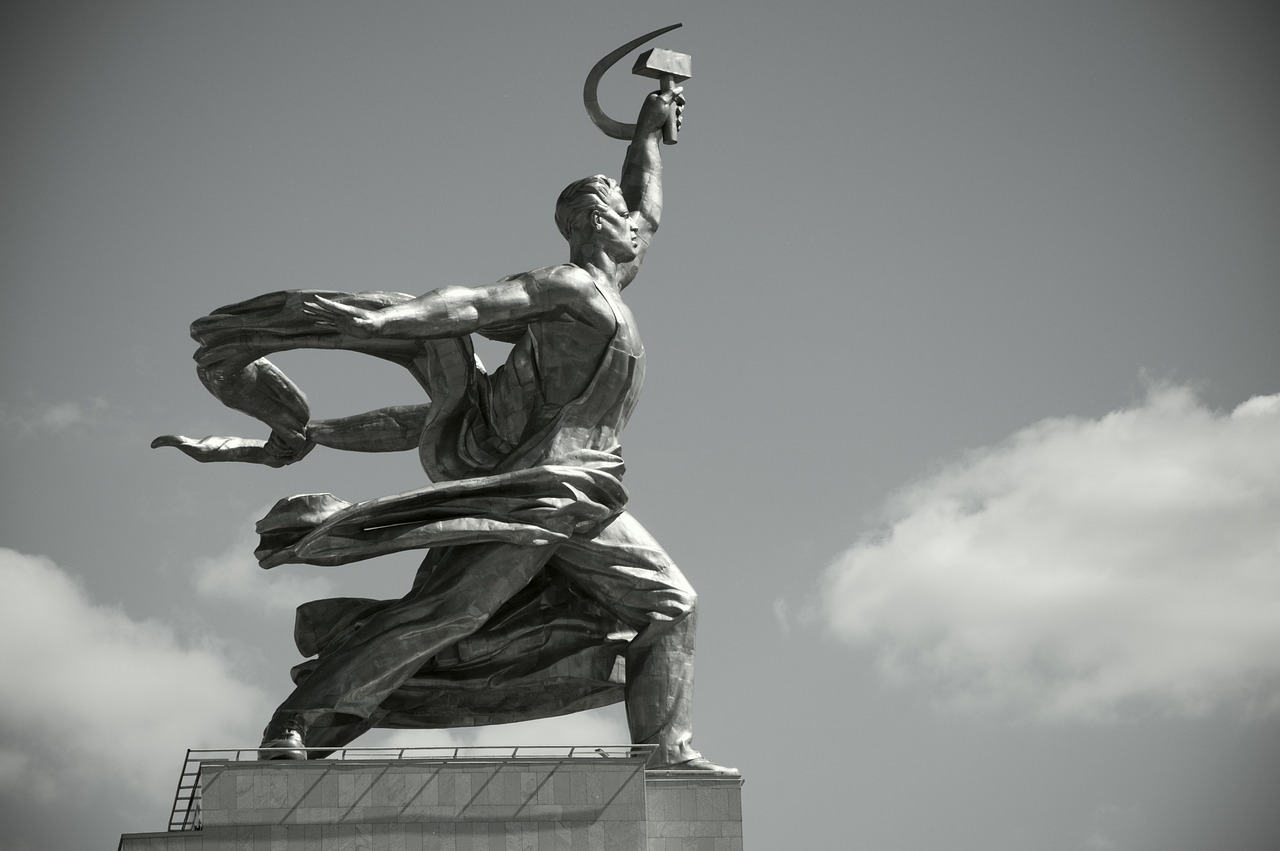
Communism in Practice: Historical Context
The journey of communism from theory to practice is a captivating tale filled with fervor, struggle, and transformation. It’s like watching a grand play unfold, with each act revealing the complexities of human society and the quest for equality. The historical contexts in which communist ideas were implemented tell us much about both the promise and pitfalls of this ideology. One of the most significant moments in this narrative was the Russian Revolution of 1917, which served as a dramatic turning point not only for Russia but for the entire world.
During the Russian Revolution, the Bolsheviks, led by Vladimir Lenin, seized power with the aim of establishing a socialist state based on Marxist principles. Imagine a group of revolutionaries storming the winter palace, fueled by the desire to overthrow the oppressive Tsarist regime. The revolution was not merely a spontaneous uprising; it was the culmination of years of social unrest, economic hardship, and a growing discontent with the existing political order. The Bolsheviks promised “peace, land, and bread,” appealing to the war-weary soldiers, the impoverished peasants, and the disillusioned workers. This slogan encapsulated the hopes and aspirations of a society yearning for change.
After the revolution, the establishment of the Soviet state marked a significant application of communist theory. The government sought to abolish private property and implement a planned economy. However, this transition was fraught with challenges. The civil war that followed the revolution, known as the Russian Civil War, pitted the Red Army against the White Army, composed of various anti-Bolshevik factions. This conflict was a brutal struggle for control, and it illustrated the intense opposition to the new regime. The Bolsheviks' victory solidified their power but also led to a series of repressive measures, including the suppression of dissent and the establishment of a one-party state.
The impact of the Russian Revolution extended far beyond Russia’s borders. It sparked a wave of communist movements across the globe, inspiring revolutionaries in countries like China, Cuba, and Vietnam. Each of these nations interpreted Marxist principles through their unique historical and cultural lenses, leading to variations in how communism was practiced. For instance, in China, Mao Zedong adapted Marxist theory to fit the agrarian context of his country, emphasizing the role of the peasantry in the revolutionary struggle. This adaptation highlights the flexibility of communist ideology and its ability to resonate with diverse populations.
However, the implementation of communism was not without its consequences. In many instances, the promise of a classless society clashed with the realities of governance. The ideological fervor that fueled revolutionary movements often gave way to authoritarian practices. As leaders sought to consolidate power, they frequently resorted to purges, censorship, and state control over various aspects of life. The result was a paradox where the goal of equality led to significant inequalities in power and privilege within the ruling elite.
To further illustrate the global spread of communist ideology and its diverse implementations, consider the following table that outlines key countries where communism took root, along with the notable leaders and events that shaped their paths:
| Country | Notable Leader | Key Event |
|---|---|---|
| Russia | Vladimir Lenin | Russian Revolution (1917) |
| China | Mao Zedong | Chinese Civil War (1949) |
| Cuba | Fidel Castro | Cuban Revolution (1959) |
| Vietnam | Ho Chi Minh | Vietnam War (1955-1975) |
As we reflect on the historical context of communism in practice, it becomes evident that the ideology's journey has been marked by both triumphs and tribulations. While it aimed to create a more equitable society, the realities of governance often led to outcomes that contradicted its foundational principles. The legacy of communism continues to evoke debate and discussion, reminding us of the complexities of human aspirations and the challenges of translating theory into practice.
- What are the main principles of communism? Communism is based on the idea of a classless society where the means of production are owned collectively, eliminating private property.
- How did the Russian Revolution influence other countries? The Russian Revolution inspired numerous communist movements worldwide, leading to revolutions in countries like China, Cuba, and Vietnam.
- What were some criticisms of communist regimes? Critics often point to authoritarian practices, lack of political freedoms, and economic inefficiencies as major failures of communist regimes.

The Russian Revolution
The Russian Revolution of 1917 stands as a monumental event in world history, marking the rise of communist ideology on a grand scale. This revolution was not merely a spontaneous upheaval; it was the culmination of deep-seated social, economic, and political tensions that had been brewing for decades. The backdrop of World War I, with its staggering casualties and economic turmoil, created a fertile ground for revolutionary ideas to take root. How did a nation on the brink of collapse transform into a beacon of communist thought? Let's dive into the events that led to this seismic shift.
Initially, the revolution can be divided into two key phases: the February Revolution and the October Revolution. The February Revolution was largely a result of widespread discontent among the working class and peasantry, fueled by food shortages and military failures. The abdication of Tsar Nicholas II created a power vacuum that the Provisional Government attempted to fill. However, this government was largely ineffective and failed to address the pressing issues faced by the populace, which included land reform and peace negotiations.
As the Provisional Government struggled, the Bolsheviks, led by Vladimir Lenin, gained traction among the disillusioned masses. They promised "peace, land, and bread," a slogan that resonated deeply with the war-weary soldiers and impoverished peasants. The Bolsheviks' ability to connect with the frustrations of the people was pivotal in their rise to power. By October 1917, they orchestrated a coup that effectively dismantled the Provisional Government, leading to the establishment of a socialist state.
The October Revolution was not just a political shift; it was a profound transformation in the social fabric of Russia. The Bolsheviks implemented radical reforms that aimed to redistribute land and wealth. They nationalized industries and established a planned economy, which fundamentally altered the relationship between the state and its citizens. However, this rapid change came with its own set of challenges, including civil war and international isolation.
To better understand the impact of the Russian Revolution, we can look at the following key outcomes:
- Establishment of the Soviet Union: In 1922, the Bolsheviks consolidated their power, leading to the formation of the Soviet Union, a state that would become synonymous with communist ideology.
- Spread of Communist Ideals: The revolution inspired communist movements worldwide, influencing political landscapes in countries like China, Cuba, and Vietnam.
- Social Reforms: The Bolsheviks implemented sweeping reforms in education, healthcare, and women's rights, aiming to create a more equitable society.
- Opposition and Civil War: The revolution sparked a brutal civil war (1917-1922) between the Red Army (Bolsheviks) and the White Army (anti-Bolsheviks), leading to widespread suffering and loss of life.
In conclusion, the Russian Revolution was a pivotal moment in history that not only reshaped Russia but also had far-reaching implications across the globe. It demonstrated the power of ideology and the potential for ordinary people to challenge and change the status quo. The lessons learned from this revolution continue to resonate, reminding us of the complexities and consequences of radical change.
1. What caused the Russian Revolution?
The Russian Revolution was caused by a combination of factors, including widespread dissatisfaction with the monarchy, economic hardship due to World War I, and the influence of revolutionary ideologies.
2. What were the main events of the Russian Revolution?
The revolution can be divided into two main events: the February Revolution, which led to the abdication of Tsar Nicholas II, and the October Revolution, during which the Bolsheviks seized power.
3. What were the consequences of the Russian Revolution?
The revolution led to the establishment of the Soviet Union, the spread of communist ideology worldwide, significant social reforms, and a brutal civil war.
4. Who were the key figures in the Russian Revolution?
Key figures included Vladimir Lenin, Leon Trotsky, and other Bolshevik leaders who played crucial roles in the planning and execution of the revolution.

Global Spread of Communist Ideology
The global spread of communist ideology is a fascinating tale of how a set of ideas can transcend borders, influence revolutions, and reshape societies. After the Russian Revolution in 1917, the seeds of communism were sown in various parts of the world, often taking root in the fertile ground of socio-economic struggles. Countries facing oppression, inequality, and colonial rule found in communism a powerful narrative that resonated with their aspirations for a better future. But how did this ideology travel so far and wide?
In the early 20th century, the Communist International, or Comintern, was established to promote the global spread of communism. This organization aimed to unite workers and revolutionary movements worldwide under the banner of Marxism. It provided a platform for sharing ideas, strategies, and resources among communist parties across different nations. This period saw a flurry of activity as communist parties were formed in countries as diverse as Germany, China, and India, each adapting Marxist principles to their unique contexts.
One of the most significant examples of this spread is the Chinese Revolution. In 1949, the Chinese Communist Party, led by Mao Zedong, successfully overthrew the Nationalist government and established the People's Republic of China. This victory was not just a national event; it sent shockwaves around the globe, inspiring revolutionary movements in Asia, Africa, and Latin America. The Chinese model of communism, with its emphasis on peasant-based revolution, differed from the European interpretation, showcasing the adaptability of communist ideology to local conditions.
As communism spread, it often faced fierce resistance from capitalist nations. The Cold War era was marked by a stark ideological battle between the capitalist West and the communist East. Countries in Eastern Europe fell under the influence of the Soviet Union, adopting communist regimes that were often characterized by authoritarian governance. This led to a significant geopolitical shift, as nations like Poland, Hungary, and East Germany became part of the Soviet sphere of influence, experiencing both the promise and the challenges of communist rule.
Furthermore, the spread of communism was not limited to state-sanctioned movements. Various grassroots organizations and labor unions adopted communist principles, advocating for workers' rights and social justice. The anti-colonial movements in Africa and Asia often found inspiration in Marxist ideology, viewing it as a tool for liberation from imperial powers. Figures like Che Guevara became icons of revolutionary struggle, symbolizing the universal appeal of communist ideals in the fight against oppression.
However, the global spread of communism was not without its contradictions and challenges. While it promised equality and justice, many communist regimes faced criticism for human rights abuses and economic failures. The disillusionment with communist governance in the late 20th century led to significant changes, most notably the collapse of the Soviet Union in 1991. This event marked a turning point, raising questions about the viability of communist ideology in the modern world.
Today, the legacy of communism continues to influence political thought and movements across the globe. While traditional communist parties may have waned in influence, the core ideas of social equity, anti-capitalism, and collective ownership still resonate in various forms, from democratic socialism to grassroots activism. The ongoing debates about wealth inequality and corporate power reflect the enduring relevance of the questions posed by communist thinkers over a century ago.
In conclusion, the global spread of communist ideology is a complex narrative filled with triumphs and tribulations. It serves as a reminder that ideas, when coupled with the struggles of the people, can lead to profound changes in society. As we look to the future, the lessons learned from the rise and fall of communism may continue to shape political landscapes and inspire new generations of activists seeking justice and equality.
- What is the primary goal of communism? The primary goal of communism is to create a classless society where the means of production are owned collectively, eliminating private property and ensuring that wealth is distributed according to need.
- How did communism spread globally? Communism spread globally through revolutionary movements, the establishment of the Communist International, and anti-colonial struggles that adopted Marxist principles to fight oppression.
- What are some criticisms of communist regimes? Criticisms of communist regimes often include authoritarian governance, human rights abuses, and economic failures that led to shortages and inefficiencies.
- Is communism still relevant today? Yes, while traditional communist parties may have declined, the ideas of social equity and anti-capitalism continue to resonate in contemporary political movements and discussions about wealth inequality.
Frequently Asked Questions
- What is the main idea behind communism?
Communism is fundamentally about creating a classless society where the means of production are owned collectively. It aims to eliminate private property to foster equality and ensure that resources are distributed based on need rather than profit. Think of it as a system where everyone shares the pie instead of a few people hogging it all.
- Who were the key philosophers behind communist theory?
The main figures are Karl Marx and Friedrich Engels. Their collaboration produced influential works like "The Communist Manifesto," which outlines the principles of communism and critiques capitalism. They believed that societal change could be achieved through class struggle and revolution.
- What is historical materialism?
Historical materialism is a method of understanding societal development through the lens of economic factors and class struggles. It posits that material conditions and economic activities shape human societies and their institutions. In simpler terms, it’s like saying that the way we produce and distribute goods influences our social structures and relationships.
- How does Marx critique capitalism?
Marx’s critique centers on the idea that capitalism inherently leads to exploitation and alienation. He argued that workers are paid less than the value they produce, creating a system where the rich get richer while the poor struggle. It’s like a game rigged in favor of a few players, leaving the rest to fight over the scraps.
- What is the labor theory of value?
The labor theory of value suggests that the value of a commodity is determined by the amount of socially necessary labor required for its production. In essence, the more effort you put into making something, the more it should be worth. It’s a way to measure worth based on human effort rather than market whims.
- What role does class struggle play in Marxist theory?
Class struggle is seen as the driving force behind social change and revolution. Marx believed that the conflict between the proletariat (working class) and the bourgeoisie (capitalist class) would eventually lead to the overthrow of capitalism and the establishment of a classless society. It’s like a tug-of-war where the tension between classes pushes society toward transformation.
- How did Hegelian philosophy influence Marx?
Hegel’s dialectical method, which emphasizes the process of thesis-antithesis-synthesis, greatly influenced Marx's thinking. Marx adapted this approach to analyze societal progress and historical development, leading to his formulation of historical materialism. It’s like using Hegel’s blueprint to build a new structure of thought that focuses on material conditions rather than ideas alone.
- What was the significance of the Russian Revolution?
The Russian Revolution of 1917 was a pivotal moment where Marxist principles were put into practice, resulting in the establishment of the Soviet state. It marked the first major attempt to create a communist society, influencing many other countries and movements around the world. Think of it as the spark that ignited a global conversation about communism.
- How did communism spread globally?
After the Russian Revolution, communist ideology spread to various countries through revolutions, political movements, and the influence of communist parties. Nations like China, Cuba, and Vietnam adopted communist principles, leading to significant socio-political changes. It’s like a wave that rolled across the globe, reshaping societies in its path.


